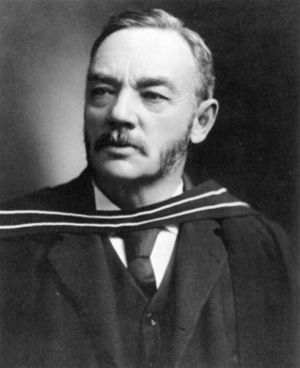John Galbraith
| John Galbraith | |
|---|---|
|
In office Succeeded by
1st Chair of Civil Engineering In office Succeeded by
?
1st President of the Engineering Society In office Succeeded by
| |
| Born |
September 5, 1846 Montreal, Quebec, Canada |
| Died |
July 21, 1914 (aged 67) Go Home Bay, Muskoka District, Ontario, Canada |
| Nationality | Canadian |
| Discipline |
Mathematics Mechanical Engineering Civil Engineering |
| Fields | Railway Engineering |
| Education |
B.A., 1868 M.A., 1875 |
| Alma mater | University of Toronto |
John Anderson Galbraith (1846-1914) was a Professor of Engineering at the School of Practical Science from its founding in 1878 until his death in 1914. He was the first Professor appointed to the School, and served as the Dean of Engineering of the Faculty of Applied Science and Engineering after its merger into the University of Toronto from 1906 to 1914. He was widely remembered as the father of formal engineering education in Canada, and was widely respected for his technical expertise as well as his teaching.
Biography[edit | edit source]
Family and Early Life[edit | edit source]
John Anderson Galbraith was born on September 5, 1846 in Montreal, Canada East. He was the son of an accountant, Thomas Galbraith (born 1822 in Coldstream, Berwickshire, Scotland), and Jane Galbraith (née Anderson). Thomas and Jane Galbraith had seven children, of whom John was the eldest. Of the seven, only four survived into adulthood - John, William (born 1848), Thomas (born 1849), and Jean (born 1851).
The Galbraiths moved from Montreal to Port Hope (approximately 70 miles east of Toronto) in 1852, where Thomas Galbraith and his brother-in-law started a dry goods store. When his father later returned to Montreal (and later, New York) as a newspaper publisher, John stayed home to care for his siblings.
John Galbraith was schooled at the Port Hope Grammar School, where he excelled in Mathematics, Latin, French, and Greek, among other subjects. In Port Hope, John Galbraith met George Stewart, a surveyor. Stewart taught John Galbraith the basics of conducting a survey, and gave Galbraith his first copy of Rankine's Civil Engineering.
Education[edit | edit source]
Galbraith initially intended to attend McGill University in Montreal, where his father lived. However, by 1862, McGill had withdrawn the only engineering course they offered. The only alternative at the time was the University of Toronto. Although there was an engineering program at the university, this course (offered at University College) was not sufficient for a degree, as engineering was considered at the time to be a mere trade.
While deciding what to do, Galbraith was introduced to John Cherriman, Professor of Mathematics, Physics and Natural Philosophy. Cherriman suggested to Galbraith that many other courses offered at the university would help in his aspirations to be an engineer. Thus, Galbraith enrolled in Arts, majoring in Mathematics, and also in Modern Languages and Natural Sciences. During the summers, he would return to Port Hope to conduct surveys with his friend George Stewart.
Galbraith graduated in 1868 from University College with a Bachelor of Arts degree, winning the gold medal in Mathematics, first class honours in Modern Languages and Natural History, and the Prince of Wales Prize.
Founding of the School of Practical Science[edit | edit source]
Honours and Later Life[edit | edit source]
Legacy[edit | edit source]
See Also[edit | edit source]
References[edit | edit source]
| School of Practical Science | ||
|---|---|---|
| First | Principal (18)9T0-(19)0T6 |
Formation of APSC |
| Faculty of Applied Science and Engineering | ||
| First | Dean (19)0T6-? |
Unknown |
| First | Civil Engineering Chair (18)7T9-? |
Unknown |
| Engineering Society | ||
| First | President (18)8T5-(18)8T8 |
Succeeded by H.E.T. Haultain |
